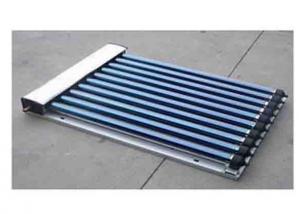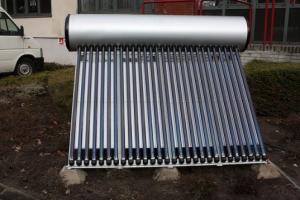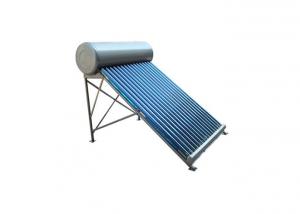S-Power Solar Collectors - Polycrystalline PV Modules Made in China
- Loading Port:
- Tianjin
- Payment Terms:
- TT OR LC
- Min Order Qty:
- 1 pallet
- Supply Capability:
- 100000000 pallet/month
OKorder Service Pledge
OKorder Financial Service
You Might Also Like
Solar panel refers either to a photovoltaic (PV) module, a solar hot water panel, or to a set of solar photovoltaic modules electrically connected and mounted on a supporting structure. A PV module is a packaged, connected assembly of solar cells. Solar panels can be used as a component of a larger photovoltaic system to generate and supply electricity in commercial and residential applications. Each module is rated by its DC output power under standard test conditions, and typically ranges from 100 to 320 watts. The efficiency of a module determines the area of a module given the same rated output – an 8% efficient 230 watt module will have twice the area of a 16% efficient 230 watt module. There are a few solar panels available that are exceeding 19% efficiency. A single solar module can produce only a limited amount of power; most installations contain multiple modules. A photovoltaic system typically includes a panel or an array of solar modules, an inverter, and sometimes a battery and/or solar tracker and interconnection wiring.
Product Description:

Solar Monocrystalline Series Panels
Introduction of Solar Monocrystalline Series Panels
CNBM Solar photovoltaic (PV) Panel is designed for large electrical power requirements. It is the optimal choice for both on-grid and off-grid power systems. CNBM Solar panel offers high performance of power per square foot of solar array. Monocrystalline silicon(c-Si): often made using the Czochralski process. Single-crystal wafer cells tend to be expensive, and because they are cut from cylindrical ingots, do not completely cover a square solar cell module without a substantial waste of refined silicon. Hence most c-Si panels have uncovered gaps at the four corners of the cells.
Characteristics of Solar Monocrystalline Series Panels
I Solar Cell : High efficiency crystalline solar cell. Even if under the weak light, the solar module can produce maximum power output.
II Tempered glass (toughened glass): Anti-reflecting coating and high transmission rate glass increase the power output and mechanical strength of solar module.
III EVA and TPT: Using high quality EVA and TPT to prevent destroying and water.
IV AI frame: Without screw, corner connection. 6 holes on the frame can be installed easily.
V Junction box: Multi function junction box with water proof.
VI Long lifetime: ≥25 years; Less power decrease
VII Good performance of preventing from atrocious weather such as wind and hails.
VIII Resisting moisture and etching effectively, not effected by geology.
Standard Test Conditions of Solar Monocrystalline Series Panels
The opto-electrical specifications shown below are stabilized values being measured at Standard Test Conditions, Irradiance: 1000W/m2, Spectrum: AM1.5 at 25°C, The info below is subject to manufacturing tolerances. Where appropriate minutes of measurement are available and are used for the dimensioning of the installation.
Advantages of Solar Monocrystalline Series Panels
• CNBM Solar performance guarantees for 25 years
• 12 years guarantee for workmanship
• Timeliness of delivery
CNBM International Corporation's products including Monocrystalline Solar Panel, Polycrystalline Solar Panel have received and enjoyed famous reputation in many countries and regions in the world .As a solar panel supplier in China, we strive to provide our customers with excellent service, superior products and unmatched value.
Characteristics of Solar Monocrystalline Series Panels
Max Power Voltage Vmp (V) | 18.4V | 17.6V |
Max Power Current Imp (A) | 6.52A | 7.39A |
Open Circuit Voltage Voc (V) | 23.0V | 22.2V |
Short Circuit Current Isc (A) | 6.97A | 7.90A |
Max Power Pm (W) | 120W | 130W |
Temperature Coefficient of Cells
NOCT | 47℃±2℃ |
Temperature Coefficients of Isc (%/℃) | 0.064 |
Temperature Coefficients of Voc (%/℃) | -0.33 |
Temperature Coefficients of Pmp (%/℃) | -0.45 |
Mechanical Data Solar Monocrystalline Series
Power | 120W/130W |
Dimension | 1190/1470×670×30mm |
Weight | 9.5kg/11.7kg |
Tolerance | ±3% |
The dimension of the modules can be changed according to the demand of clients
Limits
Operating Temperature | –40 °C to +85°C |
Storage Temperature | –40 °C to +85°C |
Max System Voltage | 700V |
Guarantee Solar Monocrystalline Series Panels
Products Guarantee | 10 yrs free from defects in materials and workmanship |
Performance Guarantee | No less than 90% within 10yrs and no less than 80% within 25yrs |
Certificates | IEC, ISO, TUV, CE |
FAQ
We have organized several common questions for our clients,may help you sincerely:
I..Will you focus on the safety of the goods during transportation?
Yes, Safety of the cargo is the primary element that we would consider on transportation.
II..How would guarantee the quality will meet the requirements of your clients?
Before shipment, we will have inspection for each batch of goods.
III..What certificates do you have?
IEC,UL,TUV,CSA,etc.
IV..Can you do OEM according to clients’ requirements?
Yes, we have our own brand while we can provide OEM service.
In the purchase of product within three working days, We will arrange the factory delivery as soon as possible. The perfect time of receiving is related to the state and position of customers. Commonly 7 to 10 working days can be served.
- Q: Can solar collectors be used in solar thermal biomass gasification?
- Yes, solar collectors can be used in solar thermal biomass gasification. Solar collectors can provide the necessary heat for the gasification process, which involves converting biomass into a gaseous fuel. By harnessing solar energy, the collectors can supplement or replace traditional heating methods, making the gasification process more sustainable and environmentally friendly.
- Q: Where is the solar collector installed in the building?
- Hello, the location of solar collectors have different species, can be placed on the roof, the angle is generally 45 degrees, you can put on the south wall and building integration, selected as a satisfactory answer Thank you!
- Q: What is the difference between flat plate and evacuated tube solar collectors?
- The main difference between flat plate and evacuated tube solar collectors is the design and efficiency. Flat plate collectors consist of a flat panel with a dark absorber plate, covered by a transparent cover, while evacuated tube collectors are made up of rows of glass tubes, with each tube containing a copper or aluminum absorber. Flat plate collectors are more common and less expensive, but they are also less efficient compared to evacuated tube collectors. Evacuated tube collectors have a higher heat retention ability due to the vacuum insulation in the glass tubes, making them more efficient in colder climates or during cloudy weather. Additionally, evacuated tube collectors can capture solar energy at a wider range of angles compared to flat plate collectors, increasing their overall performance. However, the higher cost and more complex installation of evacuated tube collectors can be a limiting factor for some applications.
- Q: Can solar collectors be used to heat swimming pools?
- Yes, solar collectors can be used to heat swimming pools. Solar collectors, such as solar panels or solar thermal systems, can absorb sunlight and convert it into heat energy, which can then be transferred to the swimming pool water through a circulation system. This helps to raise the temperature of the pool water, making it more comfortable for swimming and extending the swimming season without relying on traditional heating methods.
- Q: Can solar collectors be used in combination with radiant floor heating systems?
- Solar collectors can indeed be used alongside radiant floor heating systems, and this combination proves to be highly effective in offering sustainable and efficient heating solutions for buildings. The utilization of solar collectors, such as solar thermal panels or evacuated tube collectors, enables the sun's energy to warm a fluid, typically water or a water-antifreeze mix. This heated fluid is then circulated through a network of pipes embedded in the floors, thus providing radiant heat to the occupied space. The integration of solar collectors with radiant floor heating presents the advantage of employing renewable and environmentally friendly energy sources for space heating. By tapping into the sun's power, the dependence on fossil fuels or electricity is reduced, leading to decreased energy expenses and carbon emissions. Furthermore, solar collectors can fulfill a significant portion of the heating requirements, particularly during sunny seasons, thereby further diminishing the necessity for conventional heating systems. However, it is crucial to bear in mind that the effectiveness of this combination is contingent upon various factors, such as the climate, availability of solar resources, and system design. In areas with limited exposure to sunlight, the solar collectors may not be capable of generating sufficient heat for the radiant floor system, necessitating the utilization of an auxiliary heating source. Thus, it is imperative to conduct a comprehensive assessment of the specific conditions and demands of the building to ascertain the feasibility and optimal design of the solar collector and radiant floor heating system integration.
- Q: Are solar collectors suitable for historic buildings?
- Yes, solar collectors can be suitable for historic buildings. With proper planning and design, solar collectors can be integrated into the architecture of historic buildings in a way that preserves their aesthetic value. Additionally, solar collectors can provide sustainable energy solutions without compromising the historical integrity of the structure.
- Q: Can solar collectors be used for heating chapels?
- Yes, solar collectors can be used for heating chapels. Solar collectors, such as solar thermal panels, can convert sunlight into heat energy which can then be used for heating purposes. This renewable energy source can be utilized to warm up the chapel, reducing the reliance on traditional heating systems and decreasing greenhouse gas emissions.
- Q: Are solar collectors suitable for heating shopping malls?
- Yes, solar collectors can be suitable for heating shopping malls. Solar thermal systems can efficiently capture and convert solar energy into heat, which can then be used for space heating in large buildings like shopping malls. However, the feasibility and effectiveness of using solar collectors will depend on various factors such as the size of the mall, its energy demand, available space for installation, and the local climate conditions. Additionally, integrating solar collectors with existing heating systems may require careful planning and design to ensure optimal performance and cost-effectiveness.
- Q: Can solar collectors be used for generating electricity on oil rigs?
- Yes, solar collectors can be used for generating electricity on oil rigs. Solar collectors, also known as solar panels, convert sunlight into electricity through the photovoltaic effect. They can be installed on oil rigs to harness the abundant sunlight and generate clean and renewable energy. The electricity generated can be used to power various operations on the rig, such as lighting, equipment, and communication systems. Using solar collectors on oil rigs can reduce the reliance on traditional fossil fuels and can contribute to a more sustainable and environmentally friendly energy source. Additionally, solar panels can also help in reducing the overall carbon footprint of the oil rig by offsetting a portion of the energy consumption and reducing greenhouse gas emissions.
- Q: Are solar collectors suitable for heating retail stores?
- Yes, solar collectors are suitable for heating retail stores. They can effectively harness solar energy to provide sustainable and cost-effective heating solutions for retail spaces. This can help reduce energy costs and carbon emissions while maintaining a comfortable indoor environment for customers and employees.
Send your message to us
S-Power Solar Collectors - Polycrystalline PV Modules Made in China
- Loading Port:
- Tianjin
- Payment Terms:
- TT OR LC
- Min Order Qty:
- 1 pallet
- Supply Capability:
- 100000000 pallet/month
OKorder Service Pledge
OKorder Financial Service
Similar products
Hot products
Hot Searches


























